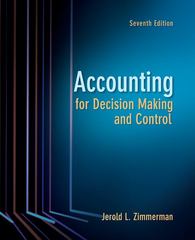Question
About This Assignment Imagine you are the new CFO for a furniture manufacturer named American Furniture Company (AFC) that has only been in business for
About This Assignment
Imagine you are the new CFO for a furniture manufacturer named American Furniture Company (AFC) that has only been in business for a few years. The company manufactures three products: wooden chairs, tables and dressers. AFC started off as a 'Mom & Pop' shop but has grown rapidly. AFC uses one assembly line to build all three products, and each product is hand-assembled before going through an automated painting process. You have been tasked with modernizing the company's accounting methods towards their future goals.
The four different parts of this assignment should be submitted together.
Part #1
Justify to the CEO what type of costing method (job-order, process costing, variable costing and/or activity-based costing) you would recommend AFC use. Assume that all of the items produced are sold. Use the following accounting data in your analysis.
Production & Cost Description............................................. Production & Cost Amounts
Annual Production..............................................................................5000 chairs/10 batches; 4000 tables/20 batches; 3000 dressers/20 batches
Raw materials in board feet (BF) per unit1............................. chair = 10 BF; 1 table = 15 BF; 1 dresser = 20 BF
Raw materials price per unit.........................................................$2 per BF
Assembly labor time (hours per unit).........................................1 chair = 5 hours; 1 table = 7 hours; 1 dresser = 10 hours
Labor pay rate.......................................................................................$15 per hour
Assembly department overhead per direct labor hour.....$5
Painting process machine hours (MH).....................................1 chair = 0.5 MH; 1 table = 1.5 MH; 1 dresser = 2 MH
Painting department overhead per MH....................................$20
Changeover cost per batch.........................................................1 chair = $100; 1 table = $150; 1 dresser = $200
Sales price.............................................................................................1 chair = $180; 1 table = $270; 1 dresser = $270
Fixed Cost..........................................................................................$50,000
Variable SG&A................................................................................$5 per unit
Fixed SG&A.....................................................................................$25,000
Within your analysis, make sure to include the following:
- Briefly discuss the advantages and disadvantages of the four costing methods.
- Narrow the choice down to two cost methods you would most recommend and provide your justification.
- Demonstrate how each of the two costing methods you chose would allocate overhead and administrative costs by calculating product costs using each method.
- Provide an income statement for each of the two methods.
- Recommend one of the two final costing methods, providing justification for your final costing method selection.
Part #2
Determine what inventory cost flow assumption (weighted average, FIFO and/or LIFO) would be best suited for valuing inventory near the current replacement cost. You will make your analysis based on the following inventory transactions involving chairs only. Remember that the sales price of chairs is $180 per unit according to the table in Part 1.
Transaction..................................Goods.....................Price
1/1 Beginning Inventory.........120 chairs.........$120/unit
1/15 Transferred into finished goods...............140 chairs.......$130/unit
3/15 Sold............110 chairs.....$180/unit
4/15 Transferred into finished goods........100 chairs...........$140/unit
6/15 Sold............90 chairs.......$180/unit
7/15 Transferred into finished goods...........130 chairs........$150/unit
9/15 Sold.......120 chairs.......$180/unit
10/15 Transferred into finished goods.........140 chairs...........$160/unit
12/15 Sold.........110 chairs...........$180/unit
Within your analysis, make sure to include the following:
- Briefly discuss the advantages and disadvantages of each inventory costing assumption.
- Calculate the cost of goods sold and ending inventory for each cost flow assumption.
- Demonstrate which of these should be used to net the highest income during inflationary periods.
- Provide justification on what inventory costing assumption you choose.
- Record journal entries for each purchase and sales transaction listed.
Part #3
You will need to submit a budget report to the CEO, including an explanation of the utility of master budgets. You will also submit a variance report that shows how the company is performing versus budgeted amounts. Use the following data.
Amount of Goods Sold Per Quarter:
................................................................Q1..............Q2.............Q3.............Q4
Chairs sold per quarter..............1150...........1200...........1250.............1400
Tables sold per quarter..............900...........950............1000............1150
Dressers sold per quarter..........650.........700.............750.............900
Target Sales Goal Per Quarter:
GoodsQuantity
Chairs...........1300
Tables...........1100
Dressers.........800
Q1 beginning inventory:
GoodsQuantity
Chairs..........120
Tables.........90
Dressers.......70
Assume that the material and labor costs from Part 1 are standards. Compare those standard costs to the actual amounts listed below. These are the actual amounts used for the entire fiscal year:
Actual amount of wood purchased and used.........................46,120 bd. ft.
Actual cost of wood purchased and used...............................$80,028
Actual amount of direct labor hours..........................................17,900
Actual cost of direct labor.............................................................$275,550
Within your analysis, make sure to include the following:
- Create variance reports for Q1, Q2, Q3, and Q4 against the Quarterly Budget.
- Generate a quarterly budget for the upcoming year that includes sales, production, materials and labor budgets. Assume a 10% increase in sales.
- Explain how a master budget can be a useful tool in aligning a company's operations to its long-term goals.
- Discuss how a variance report can be used to direct management toward production issues.
Part #4
Use the following data to generate a quote model for future business. This can be accomplished by performing a high-low or regression analysis to generate an equation relating direct labor hours to product cost:
Year.......Quarter......Direct Labor Hrs..........Manufacturing Cost
2014....Q1.....2512.......$224,950
2014.....Q.....2,432.....$214,100
2014...Q3....2,645......$226,840
2014...Q4....2,723......$228,760
2015...Q1....2,355.......$211,950
Within your analysis, make sure to include the following:
- Explain how jobs can be estimated by using a quote model based on previous data.
- Discuss the different methods of cost estimation.
Step by Step Solution
There are 3 Steps involved in it
Step: 1

Get Instant Access to Expert-Tailored Solutions
See step-by-step solutions with expert insights and AI powered tools for academic success
Step: 2

Step: 3

Ace Your Homework with AI
Get the answers you need in no time with our AI-driven, step-by-step assistance
Get Started


